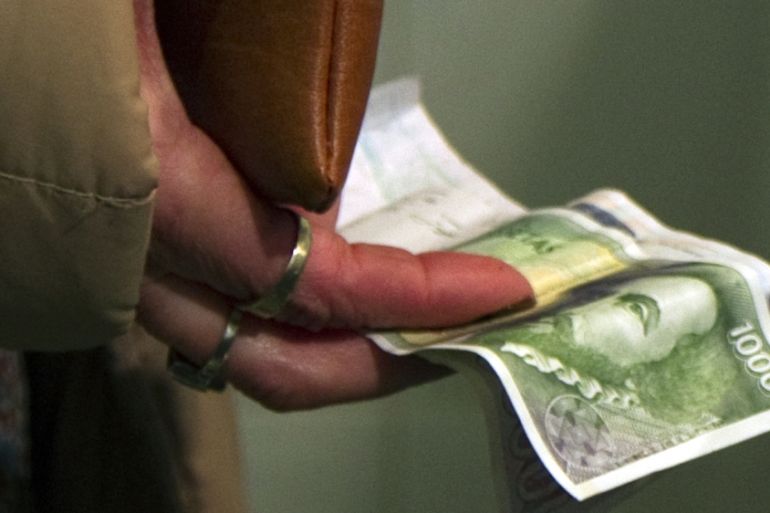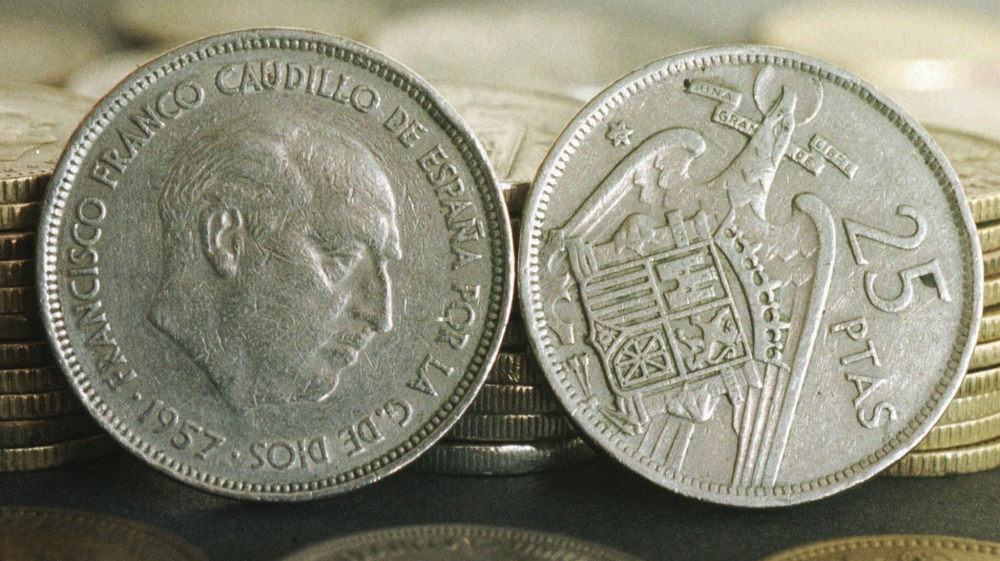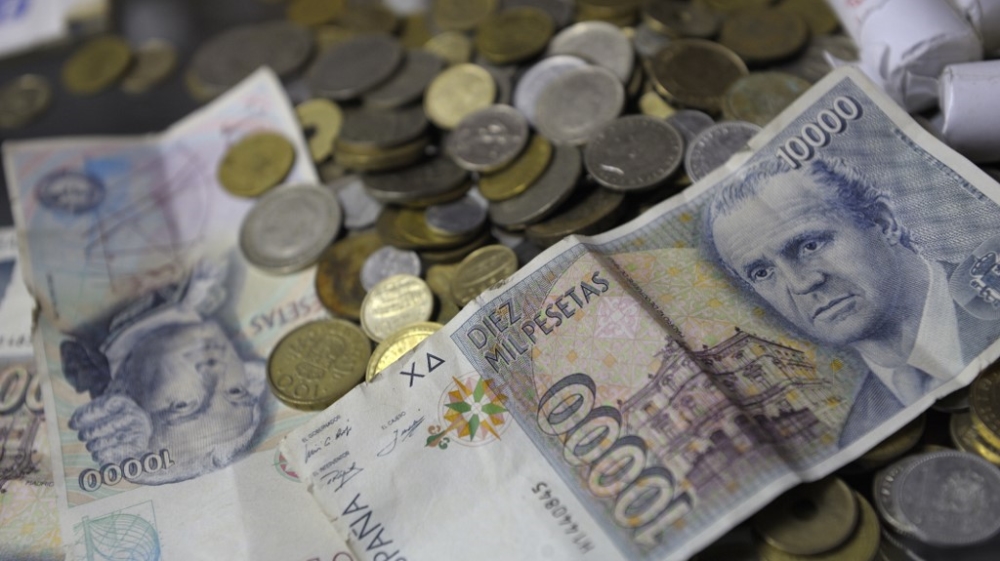Old Spanish currency to fund new coronavirus vaccine research
Citizens’ initiative is collecting Spain’s obsolete currency, the peseta, before the deadline to exchange them runs out.

When the Spanish currency, the peseta, went out of circulation in 2002 to be replaced by the euro, Isabel Gonzalez, now 49, put aside 1,700 pesetas, or 10.2 euros ($11.8) to keep as a memory of the coins that had been a big part of her life.
Several weeks ago, she decided to dust off the old coins and notes and put them to better use.
Keep reading
list of 4 itemsWhy are nations racing to buy weapons?
Parallel economy: How Russia is defying the West’s boycott
US House approves aid package worth billions for Ukraine, Israel
Gonzalez donated her obsolete money to the citizen initiative La ultima peseta (The Last Peseta), a campaign launched by a group of advertising specialists, called VIDA, to collect funds for COVID-19 vaccine research.
“They were just worthless memories, but they can help a lot of people now,” Gonzalez told Al Jazeera.
The clock is ticking for exchanging those pesetas for euros: the Bank of Spain will only accept them until the end of 2020.
“Before COVID-19, we were already looking for ideas to use those pesetas for a good cause,” Emilio Fernandez, one of the promoters of the idea, told Al Jazeera.
“It is money that would go to waste otherwise”, he said. “On an individual basis, it doesn’t mean much for most of the people, it is just a memory, but if everything is collected together, a lot of people could be helped.”

The Bank of Spain estimates that Spaniards still have about 1.6 billion euros ($1.7bn) worth of pesetas lying around in drawers and storage units.
Spain is not the only euro country where old currencies can still be exchanged. Luxembourg, Portugal, the Netherlands, Belgium, Slovenia and Slovakia still accept obsolete banknotes, but not coins.
Germany, Ireland, Austria, Estonia, Latvia and Lithuania have set no time limit for swapping them, while Cyprus, Finland, France, Greece, Italy, and Malta banks no longer accept their former currencies.
The coronavirus pandemic
In March, Spain was recording the second-highest number of new daily cases in the world, just after Italy, and the government imposed a strict lockdown that would endure for two months.
That was when Fernandez and his colleagues reached out to the Fundacion Lucha contra el Sida (Fight AIDS Foundation), an institution that has been working against HIV/AIDS since 1992 and that launched research on a COVID-19 vaccine in January.
The collective has also signed an agreement with the National Federation for Rare Diseases, which will receive part of the donations.
Funding is one of the main challenges when it comes to developing vaccines, said Julia Blanco, a scientist involved in COVID vaccine research at the IrsiCaixa AIDS Research Institute, which is linked to the Fight AIDS Foundation.
“Why we were not prepared for this pandemic? Because there hasn’t been enough funding to investigate SARS and MERS,” he told Al Jazeera.
Blanco was referring to the severe acute respiratory syndrome (SARS) and the Middle East respiratory syndrome (MERS) – two other types of coronavirus diseases that in recent years caused outbreaks, mainly in Asia and the Middle East.
Knowledge acquired during the search for other vaccines, like the research being done to find an HIV vaccine, can be helpful with SARS-CoV-2, the virus that causes COVID-19.
“HIV is a very complicated virus that mutates a lot. Since it was discovered in 1983, we haven’t been able to find a vaccine. But its research has taught us a lot about viruses in general,” Blanco said.
SARS-CoV-2 is more stable, and Blanco is confident that the first vaccines will be ready to use in about a year’s time.
“It is an exceptional situation and time frames are being shortened,” he said.
Promising trials
Last week, Oxford University announced that the experimental vaccine it is developing in cooperation with pharmaceutical company AstraZeneca had produced an immune response in more than 1,000 volunteers who had participated in the early stage of its clinical trials.
At Blanco’s laboratory, several prototypes of vaccines have already been tested in animals in collaboration with the Animal Health Research Center IRTA-CReSA and the Barcelona Supercomputing Center.
“Preliminary results are optimistic because we have observed that neutralising antibodies were generated,” Blanco said.
But it is not a race with only one winner, Blanco said. “The more vaccines we get, the better,” he said.
According to Blanco, only a wide range of vaccines would be sufficient to cope with the high demand for doses that will be needed to immunise the world’s populations.
Moreover, different vaccines may work differently on various groups, he said.
“A vaccine works with a vector that shows the fragment of the virus to the immunity system. And each vector can generate a different response, so some vaccines, for instance, may work better for older people,” he said.
The peseta
The currency that will help back the scientific process, the “pela”, as the peseta was colloquially known, has witnessed most of recent Spanish history.
The first peseta was minted in 1869, as the symbol of a new democratic government installed after the toppling of Queen Isabel II.
It would survive the tumultuous decades of the end of the 19th century and the beginning of the 20th century, including the restoration of the monarchy, two short Republican periods, the civil war (1936-1939), and the dictatorship of General Francisco Franco.

When democracy was finally reinstated in 1975, the peseta remained the official currency.
During those years, many different series of coins and notes were issued to reflect the change of governing power and the increasing cost of living.
In 2002, only a set of coins, with the profile of King Juan Carlos, were in circulation.
While any peseta note printed after 1939 can still be exchanged, only the last set of coins that were in circulation in 2002 are accepted by the Bank of Spain.
However, the previous pesetas are not useless, since they can be melted and sold in bulk, explains Emilio Fernandez. The rarest pieces can also fetch a high price in the antiques market.
“We are in contact with collectors to identify the valuable coins, but we inform their owners to make sure they want to donate them”, Fernandez said.
Moreover, many Spaniards still own commemorative silver 2,000-peseta coins, limited series issued in the late 1990s and early 2000s, whose value can reach thousands of euros.
Collecting pesetas
The main challenge is physically collecting the money. As pesetas are not currently in circulation, people cannot make bank transfers or use online payment methods.
So Fernandez and his colleagues had to go back to an old system: money boxes that were used in the past to collect donations.
The channels are also traditional: local associations, churches, religious organisations, working spaces and local stores, among others.
“For the higher donations, we can arrange some sort of transportation. But most of the people only have a few coins at home, so we have to rely on local networks,” said Fernandez.

Isabel Gonzalez has placed one of these boxes at the fashion store where she works in Elche, a town near Alicante on the Mediterranean coast.
“People are coming to donate their small bags of pesetas because they have seen the initiative in local media,” said Gonzalez. “Some other clients just go back home search for their coins when we explain to them what it is for.”
All this arduous process means that the Last Peseta initiative has only been able to verify 200,000 pesetas, or 1,200 euros ($1,398).
But they have a lot of pesetas waiting in the queue to be validated, and new contributions arrive every day.
“It is a very lengthy process because we have to check and classify every coin and banknote,” Fernandez said.
The final result will be seen in November, when all the memories Spaniards kept in the form of these bits of metal and paper, will be converted into a new hope to find a vaccine against COVID-19.